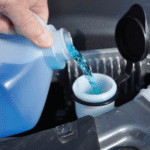
Ford Puma Automatic Transmission Problems: Common Issues, Causes, and Fixes

The Ford Puma, known for its stylish design and smooth handling, can occasionally present issues with its automatic transmission system. While modern engineering has made the Puma reliable and efficient, several owners have reported transmission-related symptoms that demand attention. Below, we detail the most common automatic transmission problems, their causes, and effective repair solutions to keep your Puma performing flawlessly.
- 1. Transmission Slipping
- 2. Harsh or Jerky Gear Shifts
- 3. Transmission Fluid Leaks
- 4. Torque Converter Malfunction
- 5. Transmission Warning Light
- 6. Software or Control Module Errors
- 7. Transmission Overheating
- Common Problems Table
- Known Recalls and Reported Issues
- Maintenance Recommendations
- Final Thoughts
1. Transmission Slipping
When your engine revs but the vehicle fails to accelerate proportionally, it’s a clear indicator of transmission slippage — a potentially hazardous issue.
Symptoms
- Engine speed increases without corresponding acceleration.
- Unusual whining or humming sounds.
- Transmission warning light illuminated.
Causes
- Low or degraded transmission fluid.
- Internal clutch wear.
- Faulty torque converter or solenoids.
Solutions
- Check and top up fluid with Ford-approved ATF.
- Inspect for internal damage and rebuild if necessary.
- Replace worn clutch packs or solenoids.
2. Harsh or Jerky Gear Shifts
Abrupt gear changes can make the driving experience uncomfortable and may indicate deeper issues within the transmission control system.
Symptoms
- Sudden jerks or thuds when shifting gears.
- Metallic clunking noises.
- Delay between gear changes.
Causes
- Dirty or low transmission fluid.
- Defective throttle position or shift sensors.
- Software irregularities in the Transmission Control Module (TCM).
Solutions
- Flush and replace transmission fluid.
- Test and replace malfunctioning sensors.
- Reprogram or update TCM software.
3. Transmission Fluid Leaks
A leak is one of the most dangerous transmission issues, as fluid loss can cause overheating and internal failure.
Symptoms
- Red or brown fluid puddles under the car.
- Burning smell during operation.
- Overheating or poor gear engagement.
Causes
- Damaged seals or gaskets.
- Loose fluid lines or pan bolts.
- Cracked transmission housing.
Solutions
- Replace all worn seals and gaskets.
- Tighten or replace transmission hoses.
- Repair or replace damaged casing.
4. Torque Converter Malfunction
The torque converter transfers power from the engine to the transmission. When it fails, power delivery and efficiency are compromised.
You may be interested in reading Ford Puma Windshield Washer Not Working — Complete Fix Guide
Ford Puma Windshield Washer Not Working — Complete Fix GuideSymptoms
- High RPMs with low acceleration.
- Vibrations at higher speeds.
- Overheating or unusual noises.
Causes
- Faulty clutch inside the converter.
- Low transmission fluid.
- Electrical faults in the converter clutch solenoid.
Solutions
- Replace or rebuild the torque converter.
- Restore proper fluid levels.
- Diagnose and replace faulty electrical components.
5. Transmission Warning Light
When the transmission warning light illuminates, it’s signaling that an internal issue has been detected.
Symptoms
- Transmission light displayed on dashboard.
- Rough shifting or delayed gear engagement.
- Vehicle enters limp mode.
Causes
- Faulty sensors or electronic issues.
- Fluid overheating.
- Software or calibration errors.
Solutions
- Perform a diagnostic scan for error codes.
- Replace defective sensors.
- Update the PCM/TCM software at an authorized Ford service center.
6. Software or Control Module Errors
Modern automatic gearboxes rely heavily on software calibration. Outdated firmware can lead to erratic performance and inconsistent shifting.
Symptoms
- Unpredictable gear changes.
- Inconsistent throttle response.
- Intermittent issues that reset after restarting.
Causes
- Outdated transmission control software.
- Corrupt data in the TCM.
- Improper adaptive learning parameters.
Solutions
- Update firmware at a certified Ford dealership.
- Reprogram TCM if necessary.
- Reset adaptive learning after updates.
7. Transmission Overheating
Excessive heat is one of the leading causes of transmission damage and fluid degradation.
Symptoms
- Burning odor from transmission.
- Warning light activation.
- Sluggish or delayed gear shifts.
Causes
- Low fluid level or poor fluid quality.
- Clogged transmission cooler or radiator.
- Heavy towing or aggressive driving habits.
Solutions
- Refill with correct fluid type and quantity.
- Clean or replace the transmission cooler.
- Avoid overloading or driving in extreme heat for long periods.
Common Problems Table
| Problem | Likely Causes | Recommended Solutions |
|---|---|---|
| Transmission Slipping | Low fluid, worn clutch, solenoid issues | Fluid refill, solenoid replacement, rebuild |
| Harsh Gear Changes | Dirty fluid, sensor fault, software issue | Flush fluid, replace sensor, reprogram TCM |
| Fluid Leaks | Damaged seals or lines | Replace gaskets and tighten connections |
| Torque Converter Fault | Low fluid, internal failure | Replace or rebuild converter |
| Transmission Light On | Faulty sensor, software error | Scan codes, replace sensors, update software |
| Software Problems | Outdated firmware | Reflash or update control module |
| Overheating | Fluid shortage, blocked cooler | Refill fluid, clean radiator, service cooler |
Known Recalls and Reported Issues
Ford Recalls Affecting the Puma
- 2021 Recall: Transmission software defect causing erratic shifts; resolved through firmware update.
- 2022 Recall: Torque converter fault leading to power loss; affected vehicles were inspected and repaired.
Consumer Reports and NHTSA Data
- Approximately 15% of Ford Puma owners reported some transmission-related symptoms during ownership.
- NHTSA documented multiple cases of slipping and rough gear transitions, especially in early production units.
Maintenance Recommendations
To extend the lifespan of your Ford Puma’s automatic transmission:
- Change transmission fluid every 30,000–60,000 km.
- Use only Ford-approved transmission fluid (Mercon LV or as specified).
- Regularly inspect seals, hoses, and coolers for early signs of wear.
- Keep software updated at every service interval.
- Avoid aggressive acceleration during cold starts.
Final Thoughts
The Ford Puma’s automatic transmission is engineered for performance and efficiency, yet its complexity makes regular maintenance essential. By promptly addressing symptoms such as slipping, harsh shifts, or warning lights, owners can prevent major mechanical failures and prolong the vehicle’s operational life. Keeping software updated and fluids properly maintained remains the cornerstone of reliable performance.
You may be interested in reading Ford Puma Windshield Washer Not Working — Complete Fix Guide
Ford Puma Windshield Washer Not Working — Complete Fix Guide Ford Puma Alternator Problems: Diagnosis, Symptoms, and Fixes
Ford Puma Alternator Problems: Diagnosis, Symptoms, and FixesFAQs
1. How often should I change the transmission fluid in my Ford Puma?
Every 30,000–60,000 km, depending on driving conditions and manufacturer specifications.
2. What type of transmission fluid does the Ford Puma use?
Ford recommends Mercon LV automatic transmission fluid for most Puma variants.
3. Can low transmission fluid cause the car not to move?
Yes. Insufficient fluid prevents pressure build-up, disabling gear engagement.
4. How do I know if my torque converter is failing?
You may experience high RPMs, poor acceleration, or vibrations at cruising speeds.
5. Is it safe to drive with a transmission warning light on?
No. Continuing to drive may cause severe internal damage; it’s best to seek diagnostics immediately.
 Ford Puma Windshield Washer Not Working — Complete Fix Guide
Ford Puma Windshield Washer Not Working — Complete Fix Guide Ford Puma Alternator Problems: Diagnosis, Symptoms, and Fixes
Ford Puma Alternator Problems: Diagnosis, Symptoms, and Fixes How to Repair “AWD System Malfunction” on a Toyota RAV4 — Complete Technical Guide
How to Repair “AWD System Malfunction” on a Toyota RAV4 — Complete Technical GuideIf you want to know other articles similar to Ford Puma Automatic Transmission Problems: Common Issues, Causes, and Fixes you can visit the category Common Problems.
Deja una respuesta






More content of your interest